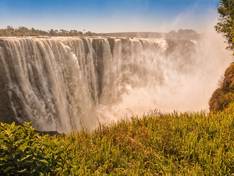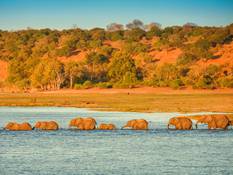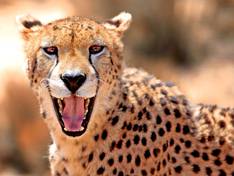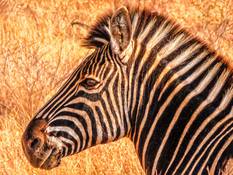The Smoke that Thunders
The wild Zambezi region, the unforgettable Okavango Delta, the world's largest elephant density in Chobe National Park and the mighty Victoria Falls
- guided tour to the biggest natural wonders of Southern Africa -
Experience the greatest highlights of Southern Africa with us - Breathtaking landscapes and unforgettable impressions are waiting for you! Accompany us on this unique and exclusive adventure trip to the natural beauties of Botswana as well as the huge Victoria Falls and some highlights of Namibia. Famous for its abundance of wildlife, Chobe National Park, the natural paradise of Okavango Delta and the mighty Victoria Falls are some of the most rewarding destinations in Southern Africa, providing a fantastic backdrop to this memorable adventure. The former Caprivi Strip and the peaceful Kavango River will inspire you and give you a feeling of boundless freedom. The friendliness of the people and the warm sun of Africa will be your constant companion. In a small group size and in a comfortable minibus, our experienced English-speaking tour guide will take you on this 14-day journey, where you will meet people of various cultural backgrounds, religions and cultures, respectfully and at an understanding level. Unforgettable experiences await in the spectacular beauty of the very original Southern Africa.
Tour Highlights
- The largest salt pan in the world
- The vast wildlife of the world famous Chobe National Park
- The mighty Victoria Falls
- The wild and romantic Zambezi region
- The peaceful Okavango River
- The mystical Tsodilo hills
- The Pearl of the Kalahari: The Okavango Delta
… and much more!!!
Itinerary
Day 1: Departure to the South
The journey begins today with a long-haul flight from your home country to Johannesburg, South Africa with a connecting flight to Maun in Botswana.
Day 2: welcome to Botswana!
At noon today you land in the city of Maun in Botswana. Here your English-speaking tour guide will welcome you with a big smile. We will then make our way to the lodge where we will be staying for the night. We have the rest of the day to relax at the pool and enjoy a sundowner. 18 km
Day 3: The largest salt pans in the world
After breakfast, your luggage will be safely packed away in our coach as we travel in an Easterly direction to Nata, on the Makgadikgadi pans. These giant salt pans are considered to be the largest in the world, with a span of more than 8,400 km². This afternoon, we will check into our lodge for the night that is situated on the edge of the pan. During late afternoon hours we can go on an impressive walk through one of the salt pans (optional - not included in the tour price). You walk in this fascinating landscape until dark, when the moon dips the salt pan in a ghostly light and the stars sparkle intensely in the clear air. You may never experience this anywhere else? 304 km / B
Day 4: To the North of Botswana
This morning we head North to Kasane on the edge of Chobe National Park. The national park was founded in 1967 as the first national park in Botswana and has an extension of 10,566 km ². Known for its huge elephant and buffalo herds, the park was named after the Chobe River, which forms the northern boundary of the park. The Chobe comes from Angola, he is called there Kuando River. Not infrequently it happens that one meets the pachyderms even in the place. We are accommodated in the beautifully situated lodge on the legendary Chobe River and sleep there to the spectacular background noise of Africa. 311 km / B,D
Day 5: The wildlife of Chobe National Park
Get up early this morning as we can get closer to the Chobe National Park game drive from our lodge (optional - not included). Especially known for its large herds of elephants, official counts in the year 2009 yielded around 120,000 copies! The Chobe area is home to numerous other large mammal species. Large predators are represented by lion, stain hyenas, cheetahs, leopards and wild dogs. Plains zebras are found in the area, as well as giraffes, hippos and warthogs. Numerous antelope species such as hartebeest, blue wildebeest, eland antelope, kudu, sable antelope, impala and waterbuck are among the fauna of the area. The park also has a rich birdlife. The lunchtime we can only use to relax in this fantastic environment. In the afternoon we can expect a really spectacular trip in a boat on the Chobe River, with further excellent chances for animal observations up close (optional - not included in the tour price). We are heading for the dramatic sunset. 0 km / h, D
Day 6: Over the border of Zimbabwe
This morning, after breakfast, our bus will travel to the exciting border crossing from Kazungula to Zimbabwe. Coming through the Zambezi National Park in Zimbabwe, we will move into our lodge in the small town of Victoria Falls in the early afternoon, which will be our home for the next two nights. In the afternoon, take part in a short but more spectacular scenic flight over the Victoria Falls (optional - not included in the tour price). 95 km / B
Day 7: Walk to the Victoria Falls
After breakfast we can expect a great highlight of our trip: on foot we will visit the huge Victoria Falls (optional - entrance fee not included in the tour price). The incredible masses of water of the Zambezi plunge here with deafening thunders into a narrow gorge, causing dense spray rising into the sky. The locals call the waterfall “Mosi-oa-Tunya” (in English the smoke that thunders). The name refers to the water spray, which rises from the falls up to 300 m in height and can still be seen up to 30 km away. In the immediate vicinity there is even a small rainforest on the falls due to the spray, which we will also visit on foot today. We walk a bit upstream through the bush, with a little luck we can also observe wildlife here. There is enough time for many photos of the truly breathtaking forces of nature. Also, we will have time this afternoon to buy last souvenirs at a handicraft market. 0 km / B
Day 8: The wild-romantic Zambezi region
After breakfast we leave our lodge in the Victoria Falls and head West across the borders of Botswana to Namibia. Today's ride takes us along the former Caprivi strip. The area is limited by the rivers Okavango, Cuando (Kwando) and Zambezi and has at a maximum width of 100 km and a west-east extension of about 500 km. Today the Caprivi strip is a true tropical paradise. The Zambezi region is the most water rich region in Namibia; This is due to both the year-round water-bearing rivers Kwando, Okavango, Sambesi, Linyanti and Chobe, as well as regular rainfalls. The vegetation is mostly dense. Along the rivers are forests and swamps. The Caprivi Strip is known as one of the most wildlife-rich areas of Namibia. Particularly large herds of elephants are seen regularly. It is not surprising that there are four reserves in this small piece of land: the Bwabwata National Park, the Mudumu National Park, the Mamili National Park and the Khaudom National Park. Thanks to the non-existent border fences around the parks, the animals can walk unhindered between Namibia, Zambia and Botswana. Here we come to a beautiful lodge on the banks of the Kwando River. On a river cruise in the late afternoon, we can get closer to the native wildlife and experience a dramatic sunset, as only the sky of Africa can offer (optional - not included in the tour price). 350 km / B
Day 9: At the end of the Caprivi strip in Rundu
On our journey further west along the Caprivi strip, we enter a very rural area. We regularly meet small settlements with thatched huts. The Kavangos living here are very warm and friendly. In the afternoon we reach the Kavango River just before Rundu, the beginning of the Caprivi strip. The Okavango River is the lifeline for the region and forms a 400 km long natural border between Namibia and the Republic of Angola. We will be staying for the next two nights in a cozy lodge, in a family atmosphere on the banks of the river, opposite the border with Angola. 426 km / B
Day 10: In the realm of the Kavangos
Directly from the lodge, we walk through rural areas and regularly go through small villages and round huts settlements of the Kavangos, where we learn a lot about their way of life. The population lives here mainly from retail, fishing and agriculture. Small, local village and street markets ensure a flourishing trade throughout the region, especially with fish and other foods. If we are lucky, the Kavangos sing and dance for us as well - the cheerfulness of these people living here is overwhelming. Along the peaceful Okavango River we walk back to our lodge. In the late afternoon we can expect a short romantic boat trip on the Okavango River (optional - not included in the tour price). 0 km / B
Day 11: Through the Bwabwata and the Mahangu Game Reserve
After breakfast we drive Eastwards and then turn South. After a short visit to the Popa Falls we drive through the Bwabwata Game Reserve and the Mahangu Game Reserve. These nature reserves characterize wide wetlands, lovely grasslands, baobab trees and dense forests. The area is home to a large number of animals, including four of the well-known "Big Five": lion, leopard, elephant and buffalo. Crocodiles and hippos as well as many waterfowl can be observed along the rivers. Known are the marshes of the Kavango River for the large elephant herds that cross the area (sometimes 100 animals and more!). Big game includes numerous antelope species such as Letschwe, Riedbock and Sitatunga, which are only found here. In addition there are bushbuck, horse and sable antelope, lyre antelope, blue wildebeest, impala, kudu and oryx, as well as buffalo, which stop here on the Caprivi. Finally, there are also a number of smaller antelope and mammal species. In addition, we can discover with some luck some of the last wild dogs of Namibia and more than 400 species of birds. In the early afternoon we cross the Namibian border into Botswana right in the middle of the game reserve and drive the remaining few kilometres to Shakawe, where we stay in a secluded lodge on the banks of the Okavango. Far away from the tourist stream, we dive into the wonderful world of the upper Okavango. A boat transfer takes us to the lodge, where we can spot countless native birds as well as crocodiles and hippos. 275km / B
Day 12: The mystical Tsodilo hills
An optional excursion can take us to the nearby Tsodilo Hills today, one of the Bushmen's last retreats and the highest point in Botswana. Tsodilo, meaning, "the rock that whispers," is an area of mystical rock formations that have survived at the Earth's surface at one billion years old. The Tsodilo hills have a similar meaning to the Bushmen as the Ayers Rock in Australia for the Aborigines. On an area of 10 km2 there is the highest concentration of rock paintings in the world. Therefore, it is called "Louvre of the Desert" and was declared a UNESCO World Heritage Site in 2001. More than 4,500 paintings have been preserved here, conveying a picture of human life and the change in local environmental conditions over the past 10,000 years. The local population venerates the place as a place where the spirits of the ancestors reside. On a walk we will discover some of the drawings of the Tsodillo hills and enjoy a breathtaking view of seemingly endless expanses. In the afternoon we drive back to our beautiful lodge on the Okavango River. Alternatively, the day can be spent relaxing in the lush and tranquil surroundings of the lodge right on the Okavango River. 102 km / B
Day 13: Through the foothills of the Kalahari Desert to the edge of the Okavango Delta
After breakfast, the boat takes us back to the parking lot where our car is parked. We then continue our journey in a Southern direction through wide bush and steppe landscapes, where we will regularly pass African huts. Seeing wild animals along the road are not uncommon here. We finally reach the Southwestern edge of the Okavango Delta in the early afternoon. Here, we leave our car in a secure car park, where a jeep will collect us and transfer us to our beautiful lodge on the Guma lagoon, an absolute paradise for anglers, nature and bird lovers. For the next two nights we will be staying in comfortable, fully equipped tents. 96 km / B
Day 14: Natural Paradise Okavango Delta
We will be spending our day in the Okavango Delta, one of the biggest highlights in Southern Africa. A boat trip takes you on an optional trip across the lagoon to the "Pearl of the Kalahari", the Okavango Delta. The Okavango forms one of the largest and most animal-rich wetlands of Africa in the semi-arid Kalahari with over 20.000 km2. Vegetation and wildlife are of overwhelming variety. So far, about 1,300 plant species have been identified throughout the delta. This morning we glide along the Delta in a typical Mokoro (carved dugout boat). An experienced ranger drives the two-seater Mokoros for us as we look for wild animals silently through the papyrus. This is very relaxing experience. An extremely diverse and dense wildlife has settled here over the millennia. To date, 71 species of fish, 33 amphibian species, 64 species of reptiles, 444 very rare bird species and 122 mammal species have been counted. The delta offers space for aquatic species such as hippos or Nile crocodiles, swamp species such as sitatunga, lechwe and waterbuck, but also for animals that rely on water for drinking. Even species that live without water for a long time can be found in the delta; like the oryx. 0 km / B
Day 15: Back to Maun and bid farewell to Botswana
This morning after breakfast, the Jeep brings us back to our parked bus. We then take a drive through a very rural area to get you to the airport in Maun, where it is time to say goodbye to Botswana. This is followed by a flight back to Johannesburg in South Africa, from where you will reach your long-haul flight back home. 301 km / B
Day 16: Back home
Arrival in home country
Prices and Dates
Prices and Dates on request.
Tour Code: Silver Pea
* The offer is valid for a group size of 6 - 9 participants.
* At the latest 30 days before departure, the achievement of the minimum number of participants is confirmed (see Terms and Conditions).
* The travel price excludes general increases in transport costs and currency fluctuations.
* Prices are subject to the availability of selected accommodation.
* We reserve the right to change the travel program at short notice.
Included in tour price:
- private, local, qualified, German-speaking tour guide from and to Maun International Airport in Botswana
- 13 nights in selected, beautiful accommodations, mostly in the three-four-star area
- Meals as advertised excl. Drinks (B = breakfast, L = lunch, D = dinner)
- Excursion and round trip program with modern, customary minibus with air conditioning
- Activities, entrances and parking fees as mentioned (except optional program items)
- Drinking water supply during bus rides- EUR 5.00 per person to support the pre-school kindergarten Penguin Kidz in Betty's Bay in South Africa
- Luggage transport
Excluded in tour price:
- International flights to and from Maun, Botswana
- optional activities and additional services
- travel Insurance
- Drinks, tips, personal expenses





